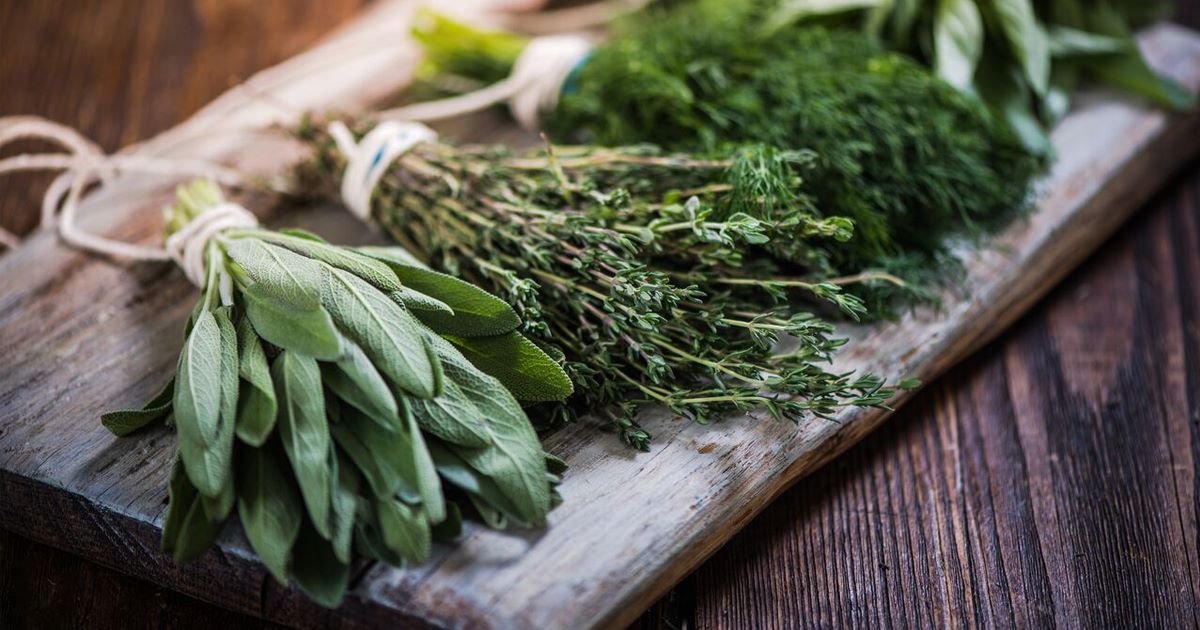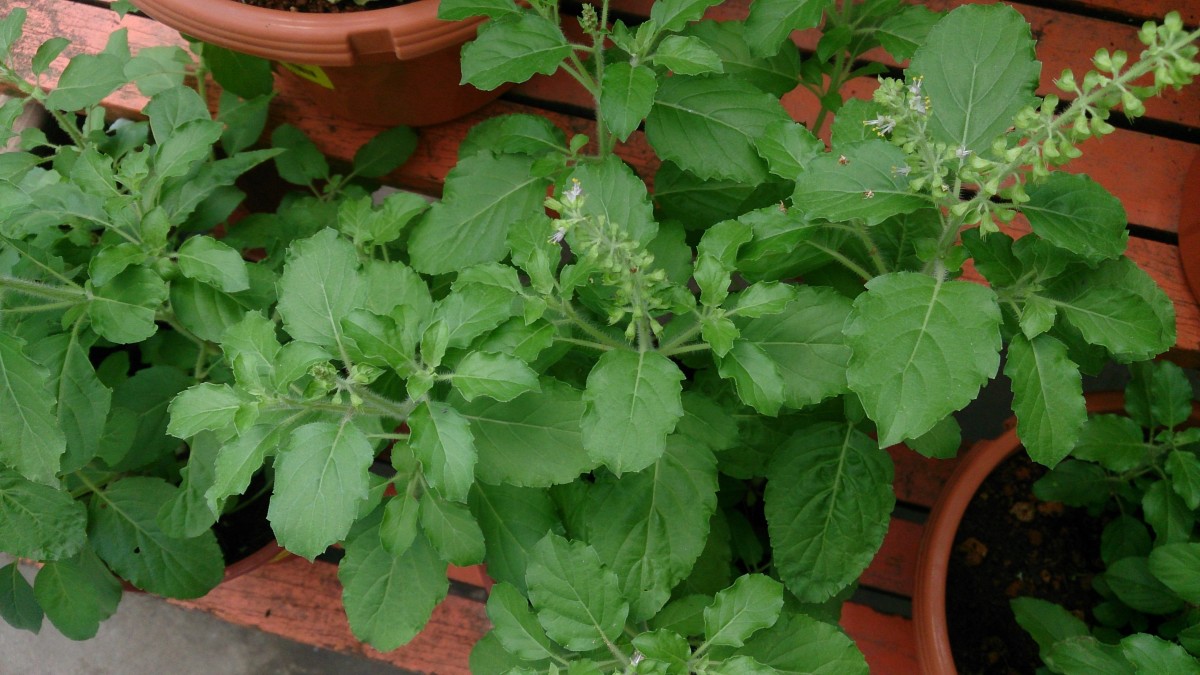Home>Gardening News and Trends>Gardening Trends>What Herbs Are Good For Pain


Gardening Trends
What Herbs Are Good For Pain
Published: September 28, 2023
Discover the latest gardening trends and explore which herbs are known for their pain-relieving properties. Enhance your garden and find natural remedies for pain.
(Many of the links in this article redirect to a specific reviewed product. Your purchase of these products through affiliate links helps to generate commission for Chicagolandgardening.com, at no extra cost. Learn more)
Table of Contents
Introduction
Welcome to the wonderful world of herbal remedies for pain relief. As more people seek natural alternatives to manage their pain, the use of herbs has gained popularity and recognition for their therapeutic benefits. Herbal remedies offer a holistic approach to pain management, addressing not only the physical discomfort but also promoting overall well-being.
Herbs have been used for centuries in traditional medicine systems across the globe. Their natural compounds provide a wide range of therapeutic properties that can help alleviate various types of pain, including headaches, muscle aches, joint pain, menstrual cramps, and more. Unlike pharmaceutical medications, which often come with side effects, herbs offer a gentle and effective solution.
Understanding the benefits and uses of different herbs is important to make informed choices and safely incorporate them into your pain management routine. In this article, we will explore ten herbs known for their pain-relieving properties.
It’s important to note that while herbs can be effective for many people, everyone’s body is unique, and results may vary. It’s always a good idea to consult with a healthcare professional before starting any new herbal regimen, especially if you have any existing health conditions or are taking other medications.
So, if you’re ready to embark on a journey to discover alternative solutions for pain relief, let’s dive into the world of herbs and explore the top ten herbs that can help ease your discomfort naturally and promote a better quality of life.
Understanding Herbal Remedies for Pain
Herbal remedies for pain relief have been used for centuries and are valued for their natural healing properties. These remedies involve the use of various plant parts, such as leaves, flowers, roots, and stems, to harness the therapeutic benefits of the herbs.
The potency and effectiveness of herbal remedies lie in the active compounds present in the plants. These compounds can have analgesic, anti-inflammatory, and muscle relaxant properties, which help reduce pain and improve overall well-being.
One of the key advantages of using herbal remedies is their holistic approach to pain management. Unlike conventional medications that often target specific symptoms or areas of the body, herbs work to restore balance and harmony to the entire body system. This approach acknowledges that pain is often a result of imbalances in the body and focuses on addressing the root cause rather than just the symptoms.
Another advantage of using herbal remedies is the relatively lower risk of side effects compared to pharmaceutical drugs. While all herbs carry some level of risk when used improperly, when used responsibly and under expert guidance, herbal remedies can be a safe and effective choice for managing pain.
It is important to note that herbal remedies should not be seen as a one-size-fits-all solution. Each person responds differently to herbs, and what may work for one person may not work for another. Additionally, it is essential to consider individual factors such as age, overall health, and any existing medical conditions before incorporating herbs into your pain management routine.
When choosing herbal remedies, it is vital to source high-quality herbs from reputable suppliers or grow them yourself, ensuring that they are organic and free from harmful pesticides and contaminants. Additionally, it is recommended to consult with a healthcare professional or a qualified herbalist who can provide guidance on the appropriate dosage and potential interactions with any medications you may be taking.
Now that we have a better understanding of how herbal remedies work for pain relief, let’s explore the top ten herbs known for their pain-relieving properties.
Top Herbs for Pain Relief
When it comes to natural pain relief, there are several herbs that have been renowned for their analgesic properties. Let’s explore ten of the top herbs that can help alleviate pain and promote a sense of well-being:
- Turmeric: This vibrant yellow spice contains curcumin, a powerful anti-inflammatory compound that can help reduce pain and inflammation. Turmeric can be taken as a supplement or added to foods and beverages.
- Ginger: Ginger has long been used in traditional medicine for its pain-relieving properties. Ginger contains gingerol, a potent anti-inflammatory compound that can help ease muscle pain and joint stiffness. It can be consumed as a tea or added to meals.
- Willow Bark: Willow bark contains a compound called salicin, which has similar properties to aspirin. It is used to relieve pain, particularly headaches and muscle aches. Willow bark is available in various forms, including teas and capsules.
- Clove: Clove oil has analgesic properties and can be used topically to numb the affected area and provide temporary relief from toothaches, gum pain, and muscle pain. It can also be used in cooking or consumed as a tea.
- Arnica: Arnica is a flowering plant known for its anti-inflammatory and analgesic properties. It is commonly used topically in the form of creams or ointments to treat bruises, sprains, and muscle soreness.
- Eucalyptus: Eucalyptus oil has a cooling effect and can help relieve pain and inflammation. It is often used topically to ease joint and muscle discomfort. Eucalyptus oil can also be added to a warm bath to soothe aching muscles.
- Chamomile: Chamomile is known for its calming and soothing properties. It can help relieve tension headaches and promote relaxation. Chamomile tea or essential oil can be used for pain relief and relaxation.
- Lavender: Lavender has analgesic and anti-inflammatory properties and is commonly used to relieve headaches and muscle pain. It can be used topically as an essential oil or added to bathwater for a soothing soak.
- St. John’s Wort: St. John’s Wort is a well-known herbal remedy for mild to moderate depression, but it also has analgesic properties. It can be taken as a supplement or used topically to relieve nerve pain.
- Valerian: Valerian root is commonly used as a natural remedy for insomnia. It has muscle-relaxing properties that can help ease tension and muscle pain. Valerian can be consumed as a supplement or brewed into a tea.
These herbs offer a natural and gentle approach to pain relief, and many of them have additional health benefits. However, it’s important to remember that herbal remedies are not a substitute for professional medical advice. If you have severe or persistent pain, it is important to seek the guidance of a healthcare professional.
Turmeric
Turmeric, a vibrant yellow spice commonly used in cooking, is also known for its powerful pain-relieving properties. The active compound in turmeric, called curcumin, has potent anti-inflammatory effects, making it a popular choice for combating pain and inflammation.
Curcumin works by inhibiting the production of inflammatory molecules in the body, reducing swelling and pain. It also has antioxidant properties that can help protect the body’s cells from damage caused by free radicals.
Research has shown that turmeric can be effective in reducing pain associated with conditions such as arthritis, muscle sprains, and other inflammatory disorders. It can also help improve joint mobility and reduce stiffness.
There are various ways to incorporate turmeric into your daily routine for pain relief. One option is to take turmeric as a supplement in capsule or powder form. Another popular method is to create a turmeric paste by mixing turmeric powder with a small amount of water or coconut oil and applying it topically to the affected area.
In addition to its pain-relieving benefits, turmeric offers a wide range of health benefits. It supports a healthy immune system, aids digestion, promotes cardiovascular health, and has been studied for its potential anticancer properties.
When using turmeric for pain relief, it is important to ensure that you are using high-quality turmeric powder or supplements from a reputable source. Turmeric is often combined with black pepper or a compound called piperine to enhance its absorption in the body.
While turmeric is generally safe for most people when consumed in moderation, it may interact with certain medications, such as blood thinners. It’s always a good idea to consult with a healthcare professional before adding turmeric to your pain management routine, especially if you have any underlying health conditions or are taking other medications.
Overall, turmeric is a versatile herb that offers natural pain relief and provides numerous health benefits. By incorporating turmeric into your daily routine, you can potentially experience relief from pain and inflammation, allowing you to live a more comfortable and active life.
Ginger
Ginger, with its distinct flavor and aroma, is not only a culinary treasure but also a powerful herb known for its pain-relieving properties. This root herb has been used for centuries in traditional medicine to alleviate various types of pain, including muscle aches, joint pain, and headaches.
The active compound in ginger, called gingerol, has been found to have potent anti-inflammatory effects. It works by inhibiting the production of inflammatory molecules in the body, reducing pain and swelling. Gingerol also acts as a mild analgesic, providing relief from discomfort.
Studies have shown that ginger can be effective in reducing pain associated with conditions such as osteoarthritis and rheumatoid arthritis. It has also been found to help alleviate muscle pain and soreness caused by intense exercise or physical activity.
Ginger can be incorporated into your daily routine in various ways for pain relief. One popular method is to consume ginger in the form of ginger tea, which can be made by steeping fresh ginger slices in hot water. You can also add ginger to your meals and beverages or take ginger supplements in capsule form.
In addition to its pain-relieving properties, ginger offers several other health benefits. It aids digestion, helps reduce nausea and vomiting, boosts immunity, and has antioxidant properties.
It is important to note that ginger may interact with certain medications, such as blood thinners. If you are taking any medications or have any underlying health conditions, it is advisable to consult with a healthcare professional before incorporating ginger into your pain management routine.
Overall, ginger is a versatile herb that provides natural pain relief and promotes overall well-being. By adding ginger to your daily routine, you can potentially experience reduced pain and inflammation, allowing you to lead a more comfortable and active lifestyle.
Willow Bark
Willow bark, derived from the bark of the willow tree, has been used for centuries as a natural remedy for pain relief. It contains a compound called salicin, which has similar properties to the active ingredient in aspirin.
The salicin in willow bark is converted in the body to salicylic acid, which has anti-inflammatory and analgesic effects. This makes willow bark an effective option for reducing pain and inflammation associated with conditions such as headaches, muscle aches, and back pain.
Unlike aspirin, willow bark is believed to have a gentler impact on the stomach lining, making it a good alternative for individuals who experience gastrointestinal discomfort with non-steroidal anti-inflammatory drugs (NSAIDs).
Willow bark can be consumed as a tea or taken in capsule form. It is also available as a topical cream for localized pain relief. However, it is important to follow the recommended dosage guidelines and consult with a healthcare professional before using willow bark, especially if you have any pre-existing conditions or are taking other medications.
It’s worth noting that individuals who are allergic to aspirin or have a sensitivity to salicylates should avoid using willow bark. Additionally, pregnant or breastfeeding women should consult with a healthcare professional before using willow bark as a pain remedy.
As with any herbal remedy, it is important to source high-quality willow bark from reputable suppliers or consult with a qualified herbalist to ensure its safety and efficacy.
Willow bark provides a natural and plant-based approach to pain relief, offering an alternative for those seeking non-pharmaceutical options. However, it is important to recognize that while willow bark can effectively alleviate pain, it may not address the underlying cause of the pain.
Incorporating willow bark into your pain management routine can potentially provide relief and improve your overall well-being, but it’s always a good idea to seek professional advice to ensure safe and appropriate usage.
Clove
Clove, with its warm and aromatic flavor, is not just a popular spice in cooking but also a powerful herb with analgesic properties. Clove contains a compound called eugenol, which has been used for centuries for its pain-relieving effects.
Eugenol acts as a natural anesthetic by numbing the nerves and reducing pain sensations. It can provide temporary relief from toothaches, gum pain, and even muscle aches and joint discomfort.
One of the most common uses of clove for pain relief is as a topical remedy. Clove oil, which is derived from cloves, can be applied to the affected area to provide temporary relief from pain and inflammation. It is important to dilute clove oil with a carrier oil, such as coconut oil or almond oil, to prevent skin irritation.
In addition to its analgesic properties, clove offers other health benefits. It has antimicrobial and antioxidant properties, which can help promote oral health and fight off free radicals in the body.
Clove can be used in various forms for pain relief. Adding whole cloves to your cooking or brewing clove tea can provide mild pain relief. For more targeted relief, you can apply clove oil topically by gently massaging it into the affected area.
While clove is generally safe when used appropriately, it is important to note that excessive use or direct application of undiluted clove oil can cause skin irritation. It’s always a good idea to test a small area of skin before applying it to a larger area.
If you have any underlying health conditions or are taking medications, it is advisable to consult with a healthcare professional before using clove as a pain remedy. They can help determine if clove is safe for you and provide guidance on appropriate usage.
Clove offers a natural and fragrant option for pain relief, particularly for oral or topical discomfort. By incorporating cloves or clove oil into your pain management routine, you can potentially experience temporary relief from pain and improve your overall well-being.
Arnica
Arnica, a flowering plant native to Europe, has been used for centuries as a natural remedy for pain relief and inflammation. It is popularly known for its ability to soothe bruises, muscle aches, and sprains.
Arnica contains several active compounds, including helenalin, which have anti-inflammatory properties. These compounds work by reducing inflammation and promoting the healing process.
Topical application of arnica is the most common way to use this herb for pain relief. Arnica creams, gels, or ointments can be applied directly to the affected area to help reduce pain and swelling. It is important to follow the instructions provided and avoid applying arnica to broken skin or open wounds.
Arnica is believed to stimulate the flow of white blood cells, which can help in reducing inflammation and clearing out metabolic waste products from the affected area.
While arnica is generally safe for external use, it is important to avoid ingesting arnica or using it on broken skin, as it may cause irritation or adverse effects. It is always best to consult with a healthcare professional before using arnica, especially if you have any existing medical conditions or are taking other medications.
It is worth noting that arnica should not be used on open wounds or applied to the eye area. Additionally, individuals who are allergic to certain plants, such as daisies or ragweed, may have an allergic reaction to arnica and should avoid using it.
Arnica can provide temporary relief from pain and help accelerate the healing process for various types of injuries, making it a useful addition to your natural pain relief toolkit. However, it should not replace professional medical care for severe or persistent pain.
By incorporating arnica into your pain management routine, you may experience relief from muscle aches, bruises, and sprains, allowing you to recover and get back to your regular activities more comfortably.
Eucalyptus
Eucalyptus, with its invigorating scent and cooling effect, is not only known for its refreshing qualities but also for its pain-relieving properties. The medicinal properties of eucalyptus have been recognized for centuries, particularly for its ability to ease respiratory problems. However, this versatile herb also offers benefits when it comes to pain relief.
Eucalyptus contains a compound called eucalyptol, which has anti-inflammatory and analgesic effects. When applied topically, eucalyptus oil can help relieve pain and reduce inflammation in the muscles and joints.
Eucalyptus oil is commonly used in topical analgesic balms and ointments, which can be applied directly to the affected area for temporary relief. The cooling sensation of eucalyptus oil can also help numb the pain and provide a soothing effect.
In addition to its pain-relieving properties, eucalyptus is known for its antimicrobial and decongestant qualities. It can help alleviate respiratory symptoms and promote clear breathing. The inhalation of eucalyptus oil can have a therapeutic effect on the nasal passages and bronchial tubes.
Eucalyptus oil can be used in a variety of ways for pain relief. You can dilute it with a carrier oil, such as coconut oil or almond oil, and massage it onto the affected area. Alternatively, you can add a few drops to a warm bath to enjoy a relaxing soak that helps alleviate muscle tension and pain.
It’s important to note that eucalyptus oil should not be ingested and should be used topically or in aromatherapy practice only. As with any essential oil, it is recommended to perform a patch test before applying it to a larger area of the skin and to consult with a healthcare professional if you have any concerns or medical conditions.
Overall, eucalyptus offers a natural and refreshing option for pain relief. By incorporating eucalyptus oil into your pain management routine, you can potentially experience temporary relief from muscle and joint pain while enjoying its invigorating scent and other health benefits.
Chamomile
Chamomile, known for its calming and soothing properties, is not only a popular herbal tea but also a herb with pain-relieving qualities. It has been used for centuries in traditional medicine for its analgesic and anti-inflammatory effects.
Chamomile contains various compounds, including chamazulene and bisabolol, that contribute to its pain-relieving properties. These compounds work by reducing inflammation and relaxing the muscles, which can help alleviate pain and promote a sense of relaxation.
One of the most common uses of chamomile for pain relief is as a tea. Drinking chamomile tea can help soothe the body and reduce pain associated with menstrual cramps, headaches, and muscle tension. The warm infusion also provides a calming effect, promoting better sleep and overall well-being.
In addition to its pain-relieving effects, chamomile offers several other health benefits. It has been found to have antioxidant and anti-anxiety properties, as well as potential benefits for digestion and skin health.
Chamomile can also be applied topically to the affected area for localized pain relief. It is available in the form of creams, ointments, or essential oils that can be gently massaged into the skin.
While chamomile is generally safe, it may cause allergic reactions in individuals who are sensitive to daisies, ragweed, or other plants in the Asteraceae family. It is advisable to perform a patch test before applying chamomile topically and to consult with a healthcare professional if you have any concerns or medical conditions.
Chamomile offers a gentle and soothing option for pain relief, promoting relaxation and well-being. By incorporating chamomile tea or topical chamomile preparations into your pain management routine, you can potentially experience relief from various types of pain while enjoying its calming and comforting properties.
Lavender
Lavender, with its sweet and floral aroma, is not just a delightful scent but also a herb with potential pain-relieving properties. Lavender has long been used for its calming and soothing effects, making it a popular choice for promoting relaxation and managing pain.
Lavender contains compounds, such as linalool and linalyl acetate, that have been found to have analgesic, anti-inflammatory, and sedative properties. These compounds can help reduce pain, inflammation, and muscle tension.
One of the most common uses of lavender for pain relief is through aromatherapy. Inhaling the scent of lavender essential oil can have a calming effect on the nervous system, helping to reduce stress and relieve both physical and emotional pain. The gentle aroma can promote relaxation and better sleep, which can indirectly alleviate pain symptoms.
In addition to aromatherapy, topical application of lavender oil can provide localized pain relief. Lavender oil can be diluted with a carrier oil, such as coconut oil or almond oil, and gently massaged into the affected area. It can help soothe muscle aches, joint discomfort, and headaches.
Lavender has other health benefits as well. It is believed to have antimicrobial properties and can help promote skin health. Lavender tea can also be consumed to enjoy its calming effects internally.
It’s important to note that while lavender is generally safe for most individuals, it may cause skin irritation or allergic reactions in some people. It is recommended to perform a patch test before using lavender oil topically and to consult with a healthcare professional if you have any concerns or medical conditions.
Lavender offers a natural and gentle option for pain relief, promoting relaxation and overall well-being. By incorporating lavender essential oil or lavender-infused products into your pain management routine, you can potentially experience relief from various types of pain while enjoying the soothing and delightful fragrance that lavender provides.
St. John’s Wort
St. John’s Wort, a bright and cheerful yellow flowering plant, is well-known for its potential benefits in managing mild to moderate depression. However, it is also a herb that offers pain-relieving properties.
St. John’s Wort contains several active compounds, including hypericin and hyperforin, that are believed to contribute to its analgesic effects. These compounds have been found to have anti-inflammatory and nerve-calming properties, making St. John’s Wort an option for alleviating certain types of pain.
The use of St. John’s Wort for pain relief is often associated with nerve-related pain, such as neuropathic pain or nerve inflammation. It is believed to help balance neurotransmitters in the brain, which can reduce the intensity of pain sensations.
St. John’s Wort can be taken in the form of a supplement or used topically as an oil or cream. When used topically, it is typically applied to the affected area to provide localized pain relief.
It’s important to note that St. John’s Wort can interact with certain medications, including antidepressants, blood thinners, and oral contraceptives. Therefore, it is advisable to consult with a healthcare professional before incorporating St. John’s Wort into your pain management routine, especially if you are taking any medications or have any pre-existing health conditions.
Additionally, it’s worth mentioning that St. John’s Wort may cause photosensitivity, making your skin more sensitive to sunlight. It is recommended to use sunscreen and avoid excessive sun exposure when using St. John’s Wort topically.
While St. John’s Wort offers potential benefits for pain relief, it may not be effective for all types of pain. It is important to seek professional medical advice to determine the appropriateness of St. John’s Wort for your specific condition.
Overall, St. John’s Wort provides a natural and potentially beneficial option for those experiencing certain types of pain, particularly nerve-related pain. By consulting with a healthcare professional and incorporating St. John’s Wort into your pain management routine, you may find relief and improve your overall well-being.
Valerian
Valerian, a herb native to Europe and Asia, is widely recognized for its calming and sedative properties. It is commonly used as a natural remedy for insomnia and anxiety. However, valerian also holds potential in the realm of pain relief.
Valerian root contains compounds, such as valerenic acid, that act as muscle relaxants and have mild analgesic effects. These properties make valerian a potential option for relieving muscle tension, spasms, and associated pain.
Valerian is often used to promote relaxation and relieve nervous tension, which can indirectly contribute to pain relief. By reducing stress and promoting a sense of calm, valerian may help alleviate pain symptoms that are exacerbated by stress or tension.
Valerian can be consumed in supplement form or brewed as a tea. Drinking valerian tea before bed may help relax muscles and promote a deeper, more restful sleep, which can indirectly benefit pain management.
It’s important to note that valerian may cause drowsiness, so it is advisable to avoid activities that require alertness after consuming valerian products. Additionally, as with any herbal supplement, it is recommended to consult with a healthcare professional before using valerian, especially if you are taking medications or have any underlying health conditions.
While valerian offers potential benefits for pain relief, it may not be effective for all types of pain. If you have persistent or severe pain, it is important to seek professional medical advice.
Overall, valerian provides a natural and calming option for promoting relaxation and supporting pain management. By incorporating valerian into your routine, you may experience relief from muscle tension and associated pain while enjoying its relaxation-promoting effects.
Using Herbs Safely and Effectively for Pain Relief
When it comes to using herbs for pain relief, it is important to do so safely and effectively. While herbs offer natural and potentially beneficial solutions, it is crucial to understand how to use them properly to maximize their potential benefits and minimize any risks.
Here are some tips for using herbs safely and effectively for pain relief:
- Consult with a healthcare professional: Before incorporating herbs into your pain management routine, it is always a good idea to consult with a healthcare professional, such as a doctor, herbalist, or naturopath. They can provide guidance tailored to your specific needs and health conditions.
- Do your research: Educate yourself about the herbs you plan to use. Research their potential benefits, recommended dosage, and possible interactions with any medications you are taking. Look for reputable sources and consider speaking with experts in the field.
- Source high-quality herbs: It is important to source herbs from reputable suppliers. Look for organic and sustainable options whenever possible to ensure purity and minimize exposure to harmful pesticides or contaminants.
- Start with lower doses: When starting with a new herb, begin with a lower dose and gradually increase as needed. This allows your body to adjust and helps identify any potential sensitivities or adverse reactions.
- Follow recommended guidelines: Always follow the recommended dosage guidelines provided with the herbal product or as advised by a healthcare professional. Taking more than the recommended amount does not always lead to better results and may increase the risk of side effects.
- Consider potential interactions: Be aware of potential interactions between herbs and any medications you are taking. Some herbs can interact with certain medications, affecting their effectiveness or causing adverse effects. Consult with a healthcare professional to ensure compatibility.
- Monitor your body’s response: Pay attention to how your body responds to the herbs you are using. If you experience any unusual or concerning symptoms, discontinue use and consult with a healthcare professional.
- Practice moderation: While herbs can be powerful tools for pain relief, it is important to practice moderation and avoid overuse or excessive reliance on herbs alone. Combining herbs with other holistic approaches, such as exercise, a healthy diet, and stress management, can provide a well-rounded approach to pain management.
Remember, herbs are not a substitute for professional medical care, especially for severe or chronic pain. They can play a supportive role in your pain management routine, but it’s important to consult with a healthcare professional for a comprehensive approach to address your specific needs.
By using herbs safely and effectively, you can tap into their natural healing properties and potentially experience relief from pain while promoting overall well-being.
Conclusion
Exploring the world of herbal remedies for pain relief opens up a myriad of possibilities for natural and holistic approaches to managing discomfort. From turmeric and ginger to willow bark and clove, each herb offers its own unique benefits and properties that can help alleviate pain and promote a better quality of life.
When using herbs for pain relief, it is essential to prioritize safety and effectiveness. Consulting with a healthcare professional and doing thorough research ensures proper usage, dosage, and potential interactions with other medications. Sourcing high-quality herbs from reputable suppliers or growing them yourself further ensures purity and minimizes exposure to harmful substances.
Remember that herbs may not work the same for everyone, and it is important to listen to your body’s response. Start with lower doses, monitor your body’s reactions, and adjust as necessary. Incorporating herbs into a holistic pain management routine, alongside other lifestyle practices like exercise, a healthy diet, and stress management, can provide a well-rounded approach to overall well-being.
While herbs offer numerous potential benefits for pain relief, it is crucial to remember that they are not a substitute for professional medical care. Severe or chronic pain should always be evaluated and managed under the guidance of a healthcare professional who can provide a comprehensive treatment plan.
By utilizing herbs safely and effectively, we can tap into the power of nature to find relief from pain, promote healing, and enhance our overall well-being. Whether it’s the vibrant turmeric, soothing chamomile, or invigorating eucalyptus, these herbs offer us a natural and gentle way to manage pain and improve our quality of life.










